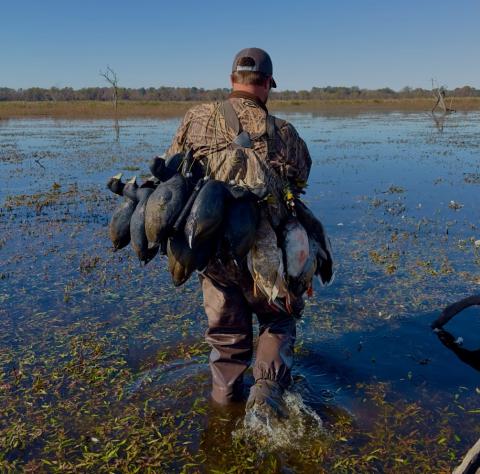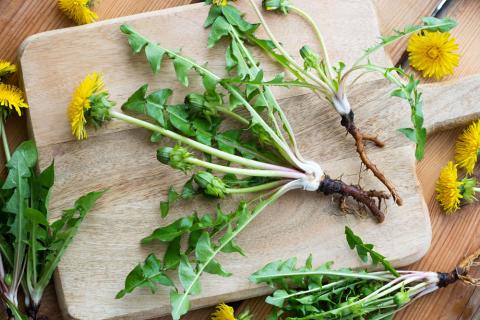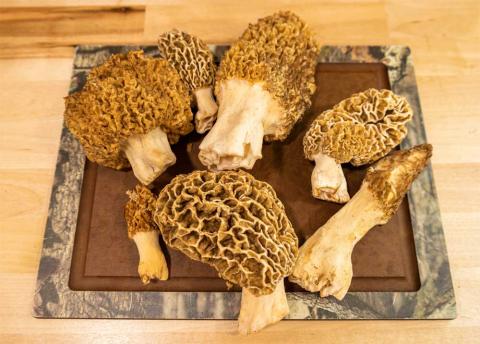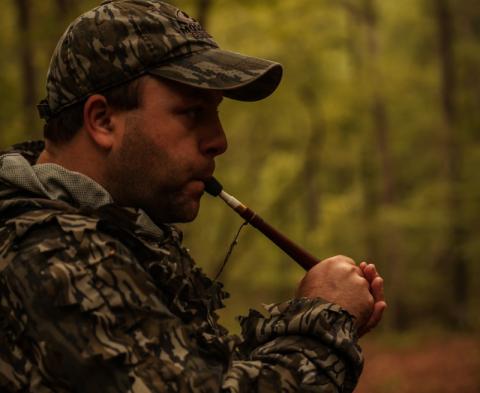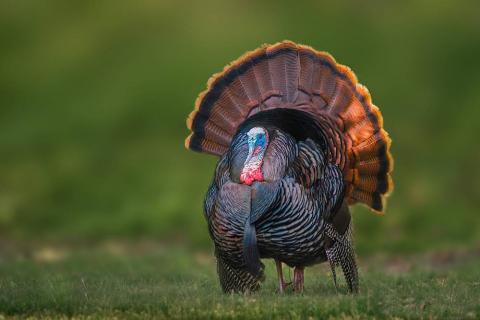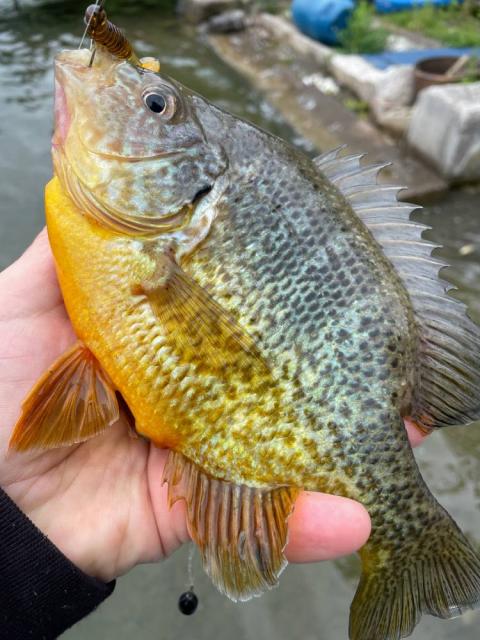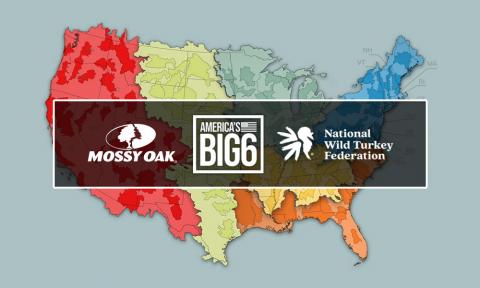Text and Photography by Tes Randle Jolly
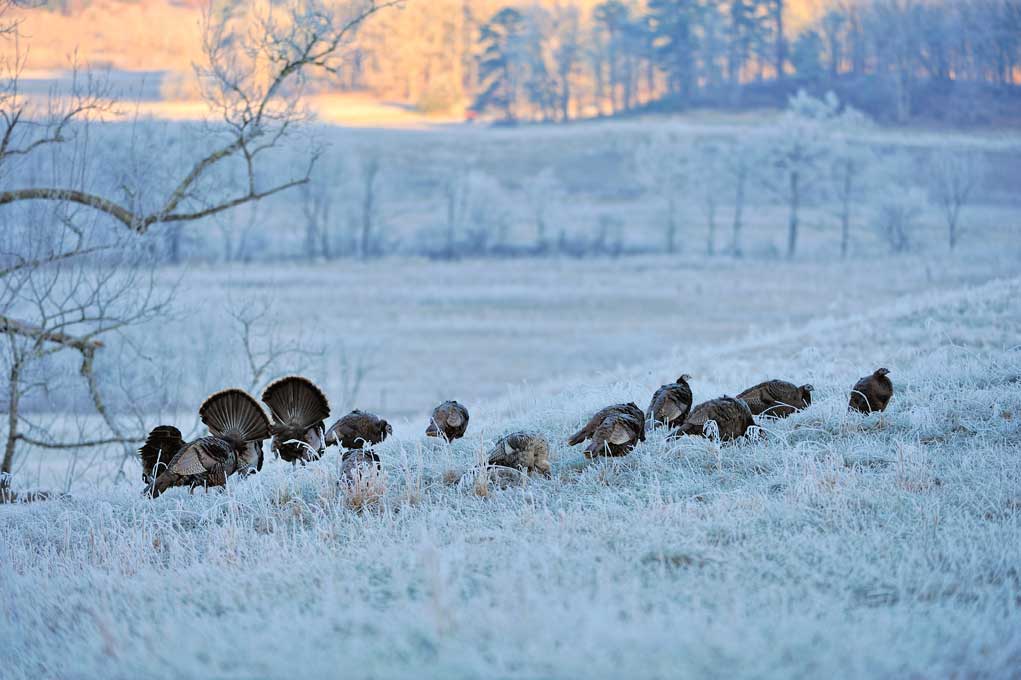
Editor’s note: Wild turkeys are a passion for many Gamekeepers and this new column will help us to better understand them. It will discuss seasonal topics such as turkey biology, behavior, oddities and habitat management from two perspectives – this author’s in-the-field observations and from wild turkey expert and researcher, Dr. Michael J. Chamberlain, PhD., Terrell Distinguished Professor of Wildlife Ecology and Management at Warnell School of Forestry and Natural Resources at the University of Georgia.
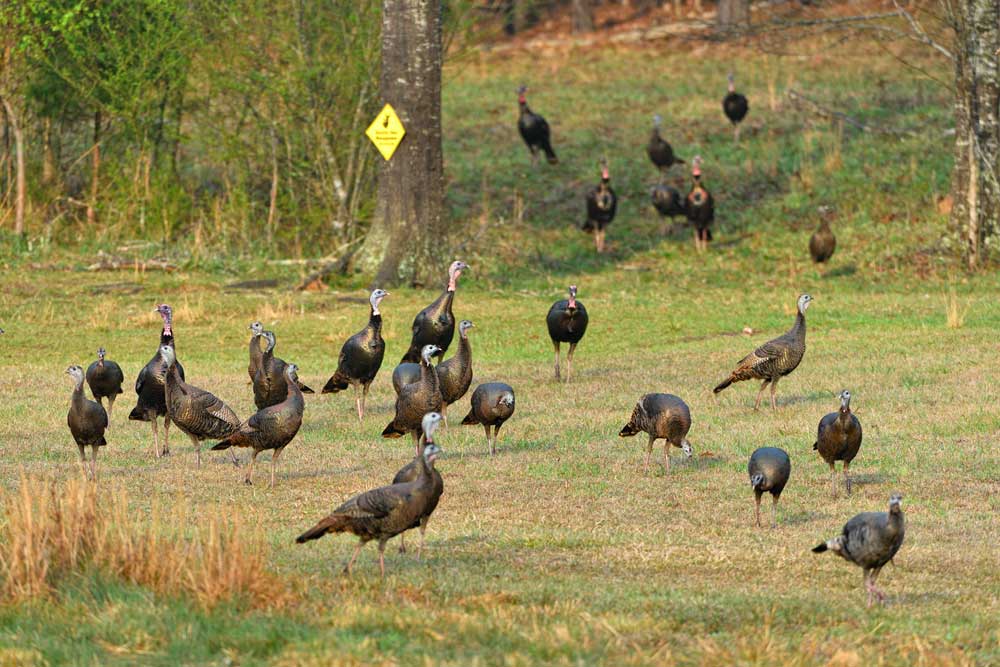
Winter flock gatherings
Huge winter flocks (think deer “yarding”) are not uncommon in colder climes. I watched as a Kentucky flock of more than 150 roosted birds scattered across a hardwood hillside as they cackled and glided into a protected valley below. What an incredible and noisy affair. The same occurred in Tennessee and Iowa. The image here shows part of a large Alabama winter flock of 66 birds. What’s with these big turkey rendezvous? There was forage available, but with all the interaction going on there had to be other reasons—safety in numbers, a social aspect, food availability, weather protection?
Dr. Chamberlain: “It is believed those huge winter flocks are a safety in numbers thing, but there is also suspicion that those flocks facilitate mixing of social groups that may contain related birds. For hens, early researchers reported that social groups blended in big winter flocks to establish pecking orders and then split out in March in a way where related hens were no longer together. But that suspicion has not been empirically tested. I have a student doing that now; she’s looking at relatedness of hens from within spring social groups to tease that out. Stay tuned.”
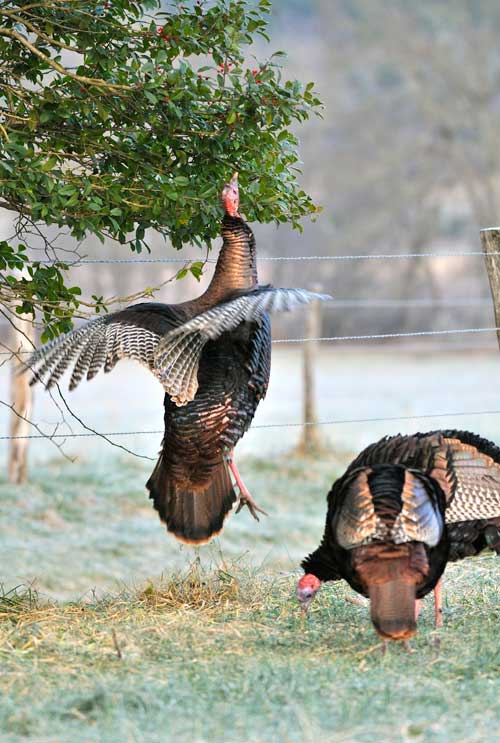
Nature’s opportunistic omnivores
Turkeys have flexible diets that vary from season to season. Typical winter foods include mast, grasses, seeds, insects, forbs, and waste grains. Given the opportunity, turkeys nab small reptiles, crustaceans and amphibians. During one harsh Tennessee winter, the mast crop failed. Several hungry gobblers gathered daily at a holly tree feeding on berries. When the ones within reach were gone, a couple of toms made comical rocket-like launches upward into the branches plucking berries with great success. Within a couple days, the tree was stripped.
Dr. Chamberlain: “We know that turkeys shift their diets during winter to higher carb foods that can provide energy. As weather gets more severe, that shift becomes more pronounced, whereas during warm snaps in winter, turkeys will often shift back and forth between hard mast/seeds and any green vegetation they can find. It makes sense, don’t stock up on high energy foods if you’re not struggling to stay warm. As far as odd foods, one of the oddest I’ve seen is some crayfish that were quite large. I watched three toms once wade around in water, it was late February and winter had been warm. There were crayfish that had emerged and were concentrated in this flooded area. Those toms were crushing those crayfish; it was pretty interesting to watch.”
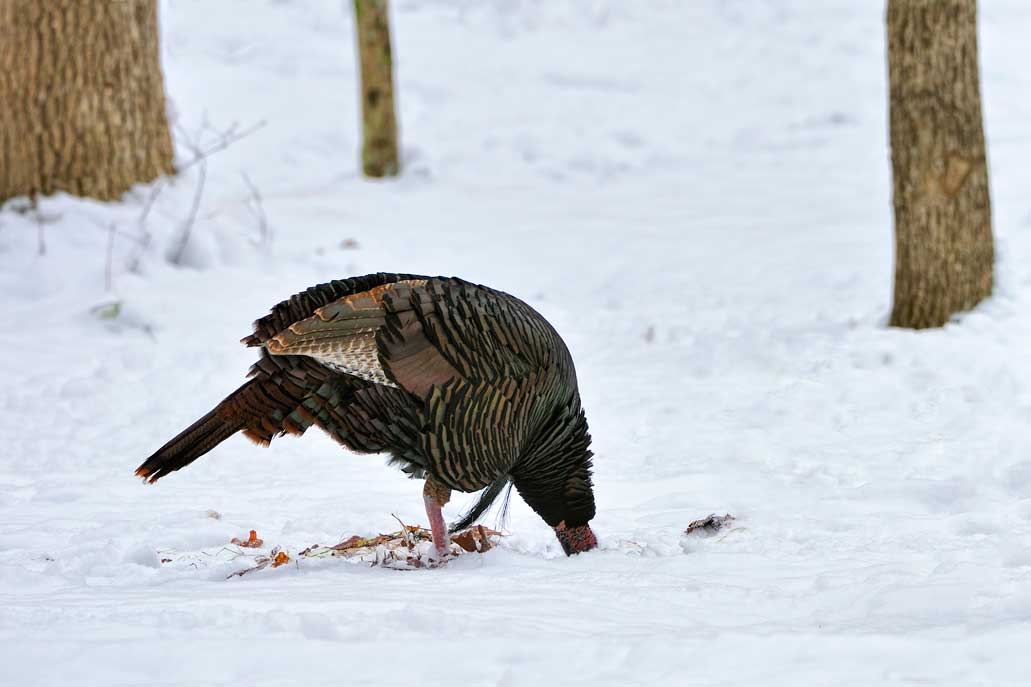
Surviving Winter
For millennia, turkeys have been scratching a living and surviving the harshest of winters. The gobbler pictured here easily scratched through several inches of snow to expose acorns. How long can turkeys remain in roost areas during extended cold, snow, ice or flood conditions? The Wisconsin DNR reports the average survival rate in mild or average winters ranges from 70 to 100 percent, but severe winters can reduce the rate to 55 to 60 percent. Turkeys can survive up to two weeks and lose up to 40 percent of their body weight before dying of starvation. Turkeys are at high risk during long periods of deep powdery snow.
Dr. Chamberlain: “Winter survival in our southern populations is very high, nearly 100 percent. Interesting side note, when the Morganza spillway was opened in 2011, one of my study areas in Louisiana went underwater with 10-plus feet of water overnight. I had birds marked with GPS, all of them died except for 1. One of the birds that died stayed in the trees for several weeks before falling out and landing on a floating mass of brush where we recovered her. She was a skeleton and had easily lost half of her body mass. I would suspect northern birds during extreme winters find themselves in the same situation.”
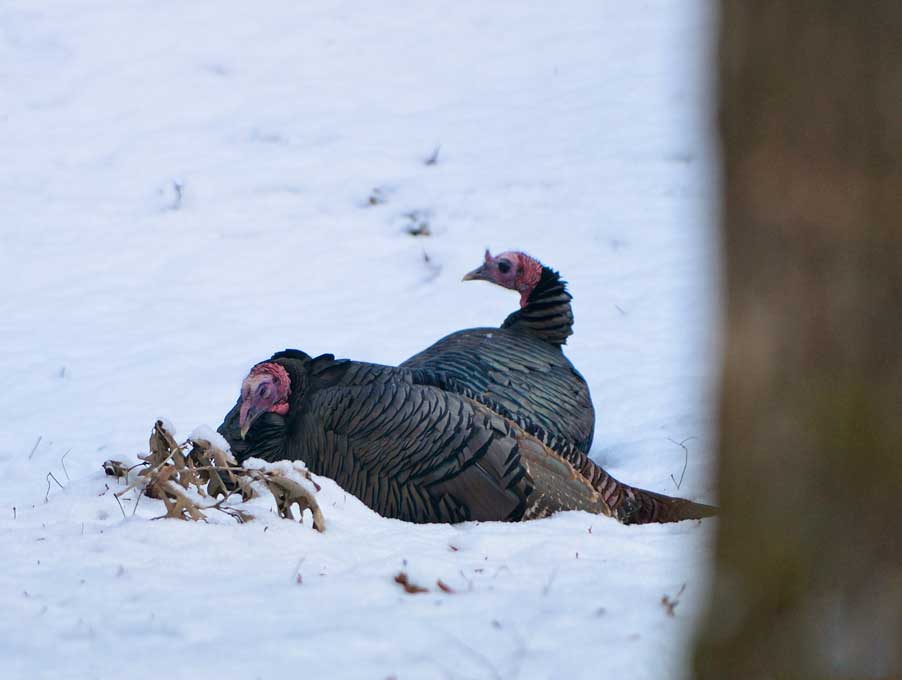
How turkeys stay warm in winter
The Tennessee toms pictured here were roosted on a protected hardwood slope and delayed fly down until an hour after sunrise. They scratched up buried acorns for short periods then crouched together in the snow with feathers puffed to retain warmth. The birds ranged only about a hundred yards that day, the limited movement conserving much needed heat and energy.
Dr. Chamberlain: “We see that during severe cold snaps, birds remain on the roost well after daylight which makes sense for several reasons. One, they can hunker down and allow the feathering on their bodies to cover their feet which are sensitive to extreme cold. Two, they don’t burn as much energy to maintain their core body temperature, which means they don’t have to obtain as much energy. Three, once they do fly down, they seek high energy foods like acorns or waste grains, something they can obtain without burning a lot of energy for what they take in. We know they squat on the roost and cover their legs with their feathers to protect the legs, and we also know that the tough scales on their legs help with temperature extremes.”
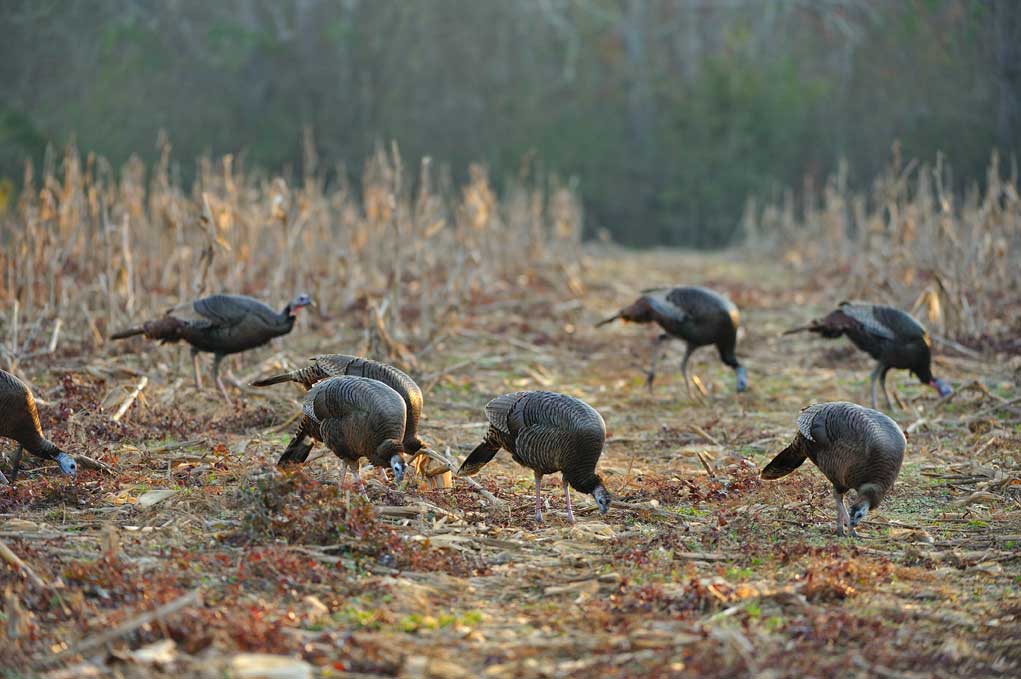
Winter range
Winter ranges in agricultural areas may be as small as 160 to 300-acres where wood lots border ag fields. Waste grains provide a large portion of their winter diet, requiring less movement if roosting habitat is nearby. Southern turkeys generally enjoy less stressful travel conditions and lighter nutritional requirements though food availability is key in determining winter range.
Dr. Chamberlain: “Range varies dramatically from year to year, area to area, even month to month. We’ve had birds literally camp out in a single hardwood bottom for weeks when there were tons of acorns, and we’ve had flocks cover 5,000-plus acres in a month during years when acorns were scarce. It all boils down to food availability, so I would assume birds using waste grain would indeed maintain smaller ranges if those fields were accessible throughout winter.
The take home is, during extreme cold the distance from roost sites to quality foraging areas becomes critical, and we see birds not traveling as much during these events. That owes to the need to maintain mast producing oaks and identify roosts near those areas – those collectively are important places for a turkey during extreme winter weather.”
WILD TURKEYS’ WINTER TO SPRING TRANSITION
Final Thoughts
One way gamekeepers can help wintering turkeys is ensuring winter roosts and mast areas with mast producing hardwoods are accessible and connected. Provide clear travel routes through thick areas that separate mast producing timber and roosts. Turkeys seem to know tractors working land means food.
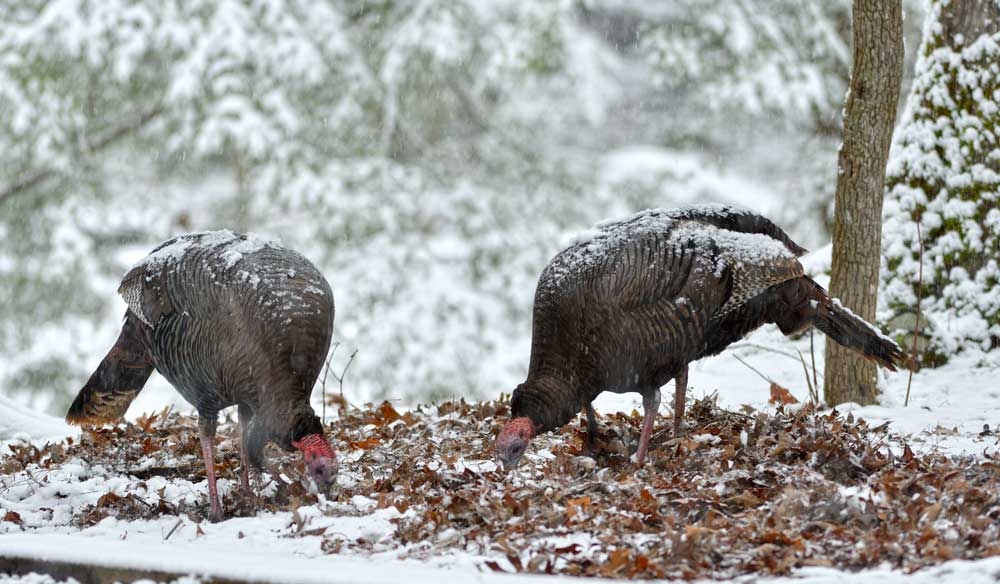
10 TIPS FOR IMPROVING WILD TURKEY POPULATIONS
Dr. Chamberlain: “Many hunters get focused on spring, but winter and how birds get through it really matters. Birds coming out of winter in good body condition can nest earlier, they have more sustainable energy reserves built up, and we think that translates to better reproductive potential – it does in other birds. Conversely, birds coming out of winter in poor body condition may delay nesting – we see this almost every year in areas where there’s poor mast crops and tough winter conditions. Later nesting is not good, as we’ve seen clearly with research that earlier nests are more successful whereas later nests produce poults that are less prone to survival. To me, that speaks to the importance of getting birds through winter in tip-top shape.
One critical thing for winter habitat would be wise management of existing hardwood forests, as you know, they’re disappearing. Things that promote mast production, such as selective thinning of non-mast producers, can not only increase acorn yield but also create valuable early successional habitat.”
















